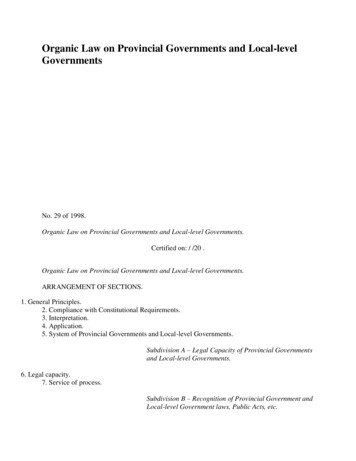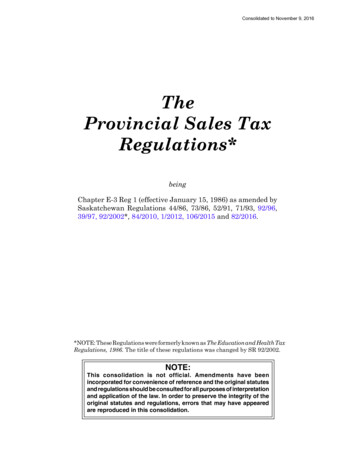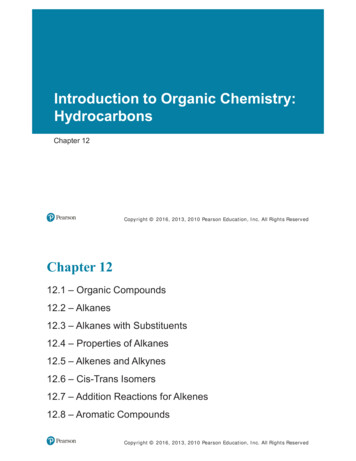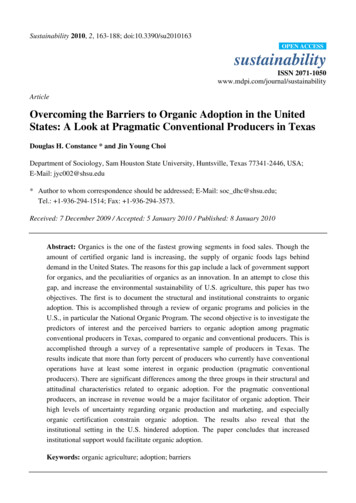
Transcription
Organic Law on Provincial Governments and Local-levelGovernmentsNo. 29 of 1998.Organic Law on Provincial Governments and Local-level Governments.Certified on: / /20 .Organic Law on Provincial Governments and Local-level Governments.ARRANGEMENT OF SECTIONS.1. General Principles.2. Compliance with Constitutional Requirements.3. Interpretation.4. Application.5. System of Provincial Governments and Local-level Governments.Subdivision A – Legal Capacity of Provincial Governmentsand Local-level Governments.6. Legal capacity.7. Service of process.Subdivision B – Recognition of Provincial Government andLocal-level Government laws, Public Acts, etc.
8. Recognition of Provincial Government and Local-level Government laws, judicial notice, etc.9. Provincial Government and Local-level Government symbols and seat of government.Subdivision A – Legislative Arm of ProvincialGovernments.10. Provincial Government and Provincial Legislature.11. Roles of Members of Parliament.12. Qualifications and disqualifications of elected members.13. Vacation of office.14. Chairman of Provincial Assembly.15. Procedures of Provincial Assembly.16. Remuneration and allowance.16A. Provincial Assembly Committees.Subdivision B – Executive Arm of Provincial Governments.17. The Provincial Governor.18. The Deputy Provincial Governor.19. Vacation of office of the Provincial Governor.20. Dismissal of Provincial Governor and Deputy Provincial Governor.21. Election of the Provincial Governor in the event of vacancy.22. Political and executive responsibilities of the Provincial Governor and the Deputy ProvincialGovernor.23. Provincial Executive Council.24. Procedures of Provincial Executive Council.25. Provincial Executive Council Committees.Subdivision A – Form of Local-level Governments.26. Local-level Governments.27. Establishment of Local-level Governments.28. Abolition of Local-level Governments.Subdivision B – Legislative Arm of Local-levelGovernments.29. Composition of Local-level Governments.30. Vacation of office.31. Qualifications and disqualifications.32. Procedures of Local-level Governments.33. System of Committees.33A. Joint District Planning and Budget Priorities Committee.34. Duration of office.35. Remuneration and allowances.
Subdivision C – Executive Arm of Local-levelGovernments.36. Local-level Government executive arm.37. Local-level Government elections.38. Eligibility of candidates.39. Death of Member not to disrupt elections.40. Principles of division of law-making powers.41. Law-making powers of the National Parliament, etc.Subdivision A – Law-Making Powers.42. Law-making powers of the Provincial Legislatures.Subdivision B – Principal Administrative Functions ofProvincial Governments.43. Principal administrative functions of Provincial Governments.Subdivision A – Law-Making Powers.44. Law making powers of the Local-level Governments.Subdivision B – Principal Administrative Functions.45. Principal administrative functions of Local-level Governments.46. Extent of powers as to judicial matters.47. Village Courts.48. Other Provincial Courts and Tribunals.49. Court fees, fines, etc.50. Delegation of powers and functions.51. Withdrawal of powers, functions and finances.52. Return of powers and functions.53. Compliance with certain conditions.Subdivision A – Suspension Generally.54. Application of Subdivision A.55. Grounds of suspension.56. Powers of Minister where he is of the opinion that a ground for suspension may exist.57. Duties of National Executive Council on submission of report, etc.58. National Executive Council may suspend a Provincial Government or a Local-levelGovernment.59. Notification of suspension to Parliament.60. Investigation by National Investigation Committee.61. National Investigation Committee.
62. Passing of suspension motion and circumstances in which provisional suspension lapses.63. Commencement of suspension.Subdivision B – Effect, etc., of Suspension.64. Application of Subdivision B.65. Effect of suspension.66. Exercise of legislative powers, etc., of suspended Provincial Governments and Local-levelGovernments.67. Exercise of executive powers, etc., of Suspended Provincial Governments.67A. Exercise of executive powers, etc., of Suspended Local-level Governments.68. Validity and effect of exercise of suspended powers, etc.Subdivision C – Re-establishment.69. Affirmation of power of re-establishment.70. Lifting of suspension.71. Post-suspension conditions.72. Provincial and Local-level Administrative System.73. Provincial and District Administrators.74. Functions of the Provincial and District Administrator.75. Provincial Government and Local-level Government staffing.76. Assigned officers of the National Public Service.77. Teaching Service.78. Other staff.79. General duties of the assigned etc., personnel.80. National Government functions.81. Provincial Government and Local-level Government support services.Subdivision A – Preliminary.82. Outline of Provincial Government and Local-level Government finances.Subdivision A – Taxation Matters.83. Provincial taxation generally.84. Government exemptions.Subdivision B – Provincial and Local-level Taxes.85. Exclusively Provincial taxes.86. Kinds of Provincial Government taxes and fees.87. Kinds of Local-level Government taxes and fees.Subdivision C – Other taxes and fees, etc.
88. Court fees and fines.89. Other taxes, charges, etc.90. Anti-discrimination.Subdivision D – Financial Grants and Assistance.91. Types of provincial and local-level grants.92. Administration Support Grants.93. Development Grants.94. Town and Urban Service Grants.95. Other Conditional Complementary Support Grants.95A. District Support Grants.95B. Provincial Support Grants.96. Equitable factor.97. Economic grants.Subdivision E – Benefits from Natural Resources.98. Benefits derived from natural resources.Subdivision F – National Government Incomes.99. Sharing of National Government Incomes.Subdivision G – Investments.100. Investment by Provincial Governments and Local-level Governments.Subdivision H – Loans, Borrowings and Guarantees.101. Loans, borrowings and guarantees by Provincial Governments and Local-level Governments.Subdivision I – Accounting and Internal Control System.102. Accounting records.103. Internal control system.Subdivision J – Inspection of Accounts.104. Inspection of financial records.Subdivision K – Financial autonomy and responsibility.105. Financial responsibility.105A. Financial responsibility.
Subdivision L – Planning and Data System.106. Provincial Planning and Data System.107. Disclosure of interest by Members of Provincial Governments and Local-levelGovernments.108. Misconduct in office.Subdivision A – Personnel Management.109. The assigned personnel.Subdivision B – Provincial and Local-level ServiceMonitoring Authority.110. Establishment of Provincial and Local-level Service Monitoring Authority.Subdivision C – Administrative Appeal System.111. Provincial and Local-level Administrative Appeal System.Subdivision D – Provincial Treasury.112. Establishment of Provincial and District Treasury.Subdivision E – Provincial Audit Service.113. Provincial Audit Service.Subdivision F – Year-end Accounts.114. Submission of provincial accounts.115. Control of natural resources.116. Resource development process.Subdivision A – Fiscal Relationship.117. National Economic and Fiscal Commission.Subdivision B – Mediation and Arbitration Power.118. Mediation and Arbitration Tribunal.119. Reports on the affairs of Provincial Governments and Local-level Governments.120. Repeal.Subdivision A – Interpretation.
121. Interpretation.Subdivision B – Abolition of Provincial GovernmentsConstituted under the repealed Laws.122. Abolition of Provincial Governments as constituted under the Repealed Laws and seats of membersof those Provincial Governments.Subdivision C – Interim Provincial Assembly.123. Interim Provincial Government.124. Powers of the Head of State.125. Composition of Interim Provincial Governments.126. Functions and powers of Interim Provincial Government.127. Meetings.128. Interim Provincial Executive Council.128A. System of Committees for Interim Provincial Executive Councils.128B. Interim Joint District Planning and Budget Priorities Committee.129. Administrative system.130. Provincial Government and Local-level Government Properties, Assets and Liabilities.131. Continuity of Government.132. Adoption of former Provincial and other laws.Subdivision D – Savings, etc.133. Saving of contracts etc.134. Registration of title of land.135. Ending legal proceedings.136. Transfers etc., from Interim Provincial Government to Provincial Government.136A. Application of other laws.137. Directions.138. Interpretation of Provincial Laws and Local-level Laws.139. Consultation generally.140. Notice of Provincial Laws and Local-level Laws.141. Commencement of Provincial Laws and Local-level laws.AN ACTentitledOrganic Law on Provincial Governments and Local-level Governments,PreambleWe, the representatives of our People in the National Parliament, in responding to the nationwidecall of our people to bring about substantive reforms to our Provincial Government system, haveresolved–(a) to make such changes as are necessary now contained in this Organic Law for the purposesof–
(i) maintaining our identity as a sovereign united nation; and(ii) promoting equal opportunity and popular participation in government at all levels; and(iii) providing especially the basic human needs for water, health, education, transportation,communication, accommodation and social order through economic self-reliance; and(iv) promoting responsible citizenship through self-management, control and accountability forone’s actions; and(b) to establish Provincial Governments and Local-level Governments in order to achieve thegoals referred to in Paragraph (a).Being an Organic Law–(a) to implement Part VIA (Provincial Governments and Local-level Governments) of theConstitution by making provision for and in respect of a system of Provincial Governments andLocal-level Governments for the provinces pursuant to the Second National Goal (Equality andParticipation) of the National Goals and Directive Principles of the Constitution; and(b) to repeal and replace the Organic Law on Provincial Government,and for related purposes,MADE by the National Parliament, to come into operation–(a) in so far as relating to all provinces other than Bougainville Province and the National CapitalDistrict–on certification; and(b)[1] in so far as relating to Bougainville Province–on 1 January 1999; and(c)[2] in so far as relating to the National Capital District–in accordance with a notice published inthe National Gazette by the Head of State, acting with, and in accordance with, the advice of theMinister.PART I. – PRELIMINARY.Division 1. – General Principles of Provincial Governments and Local-level Governments.1. GENERAL PRINCIPLES.(1) Subject to the Constitution, in exercising any power vested by this Organic Law or byany other law, all Provincial Governments and Local-level Governments shall observe thegeneral principles stated in this Division.(2) Subject to the Constitution, each Provincial Government and Local-level Government or itsagent, or public authority or its agent shall, in carrying out its functions, duties andresponsibilities, comply with–(a) the principle of–(i) mainly elective (elected directly or indirectly) representative and participatory government;and(ii)[3] appointment on merit to all public offices; and(iii) efficient and effective government; and(iv) ensuring the proper use and care of all public properties; and(v) accountability in the use of public finances, properties and as public power; and(vi) human rights as recognised and enforced by Papua New Guinea law; and(vii) treating all persons as human beings of equal worth and dignity; and(viii) acting honestly and fairly and upholding respect for, and dignity of, government; and
(b) the Fourth National Goal (Natural Resources and Environment) of the National Goals andDirective Principles of the Constitution.(3) A public authority shall be adequately resourced in order to perform all or any of its functionsconferred by law.(4) In principle, the elected leaders are responsible for the formulation of policies and the officersare responsible for the implementation of those policies, and in any case the two shall worktogether for the benefit of the people.(5) The wealth generated by lawful exploitation of any natural resources must be equitablydistributed by the National Government, the Provincial Governments and Local-levelGovernments for the benefit of resource owners and all levels of governments.(6) All levels of government and governmental bodies shall recognise traditional land rights andother rights and shall ensure that adequate compensation is made for the loss of such rights.(7) The general principles in this section are non-justiciable but may be used in the interpretationand implementation of this Organic Law.Division 2. – Compliance with Constitutional Requirements, Interpretation and Application.2. COMPLIANCE WITH CONSTITUTIONAL REQUIREMENTS.This Organic Law, to the extent that it regulates or restricts a right or freedom referred toin Subdivision III.3.C (qualified rights) of the Constitution, namely–(a) the right to freedom from arbitrary search and entry conferred by Section 44 of theConstitution; and(b) the right to privacy conferred by Section 49 of the Constitution; and(c) the right to freedom of information conferred by Section 51 of the Constitution,is a law that is made for the purpose of giving effect to the public interest in public order andpublic welfare.3. INTERPRETATION.(1) In this Organic Law, unless the contrary intention appears–“Chairman” means the Chairman of a Provincial Assembly in accordance with Section 14;“Deputy Provincial Governor” means a Deputy Provincial Governor of a province elected inaccordance with Section 18;“district administrative headquarters” means a district administrative headquarters establishedunder Section 72;“District Administrator” means a District Administrator appointed under Section 73;“Electoral Development Authority” means an Electoral Development Authority establishedunder the Electoral Development Authority Act 1992;“Interim Chairman” means the person holding the office of Chairman of an Interim ProvincialGovernment in accordance with Section 125(3) or (4);[4]“Interim Deputy Chairman” means the person holding the office of Deputy Chairman of anInterim Provincial Government in accordance with Section 125(5) or (5A);[5]“Interim Deputy Governor” means the person holding the office of Interim Deputy Governorof a province in accordance with Section 125(5) or (5A);“Interim Provincial Assembly” means an Interim Provincial Assembly of a province in
accordance with Section 123;“Interim Provincial Executive Council” means an Interim Provincial Executive Council of aProvince in accordance with Section 123(2);“Interim Provincial Government” means an Interim Provincial Government of a provinceestablished by Section 123(1);“Interim Provincial Governor” means the person holding office as Interim Provincial Governorunder Section 125(3) or (4);“Local-level Government” means a Local-level Government established in accordance withSection 26 and 27;“Local-level law” means a law made by a Local-level Government in accordance with thisOrganic Law;“Mediation and Arbitration Tribunal” means the Mediation and Arbitration Tribunal establishedunder Section 118;“National Economic and Fiscal Commission” means the National Economic and FiscalCommission established by Section 117;“National Investigation Committee” means the National Investigation Committee established bySection 61;“Provincial Administrative Headquarters” means a Provincial Administrative Headquartersestablished by Section 72;“Provincial Administrator” means a Provincial Administrator appointed under Section 73(2);“Provincial Assembly” means a Provincial Assembly established by Section 10;“Provincial Audit Service” means a Provincial Audit Service established under Section 113(1);“Provincial Auditor” means a Provincial Auditor appointed under Section 113(2);“Provincial and District Treasury” means a Provincial and District Treasury established bySection 112;“Provincial Executive Council” means a Provincial Executive Council established under Section23;“Provincial Government” means a Provincial Government established under Section 10;“Provincial Governor” means the person holding office as Provincial Governor in accordancewith Section 17 or 21;“provincial law” means a law made or adopted by a Provincial Government in accordance withthis Organic Law;[6]“Provincial and Local-level Service Monitoring Authority” means the Provincial and Locallevel Service Monitoring Authority established by Section 110;“Special Investigating Committee” means a Special Investigating Committee appointed underSection 51(1)(b).[7]“urban Local-level Government” means a Local-level Government for an area declared as anurban area under the Local-level Governments Administration Act 1997.(2) Unless the context otherwise requires, a reference in this Organic Law–(a) in relation to a province or to a Provincial Government, to a provincial body or provincialoffice referred to in Subsection (1), is a reference to the provincial body or provincial officeestablished or appointed for or in relation to that province or Provincial Government; and(b) in relation to a district or to a Local-level Government, to a provincial or local-level body orprovincial or local-level office referred to in Subsection (1), is a reference to the provincial orlocal-level body or provincial or local-level office established or appointed for or in relation tothat district or Local-level Government.
4. APPLICATION.(1) The system of Provincial Governments established by this Organic Law applies to thegovernment of the National Capital District and the provisions of this Organic Law relating toProvincial Governments apply to the National Capital District.(2) For the period on and from the date of coming into operation of this Organic Law until thedate fixed for the return of the writs following the next general election held after the date ofcoming into operation–(a) the system of Interim Provincial Governments provided for in Subdivision VI.3.C shallapply; and(b) the provisions of the remainder of this Organic Law shall apply only to the extent necessaryto enable the operation of the Interim Provincial Governments in accordance with SubdivisionVI.3.C.(3) The provisions of Subsection (2) do not apply in relation to Bougainville Province and theNational Capital District.Division 3. – System of Provincial Governments and Local-level Governments.5. SYSTEM OF PROVINCIAL GOVERNMENTS AND LOCAL-LEVEL GOVERNMENTS.(1) A system of Provincial Governments and Local-level Governments is herebyestablished.(2)[8] [9]Subject to the Constitution, the system of Provincial Governments and Local-levelGovernments established by Subsection (1), shall be implemented in accordance with thisOrganic Law and an Act of the Parliament.Division 4. – Legal Status of Provincial Governments and Local-level Governments.Subdivision A. – Legal Capacity of Provincial Governments and Local-level Governments.6. LEGAL CAPACITY.A Provincial Government or a Local-level Government–(a) may acquire, hold and dispose of property of any kind; and(b) may sue and be sued,and a provincial law or a local-level law may make provision for and in respect of the mannerand form in which each respective government may do so.7. SERVICE OF PROCESS.Any notice, summons, writ or other process required to be served on a ProvincialGovernment or a Local-level Government may be served on an officer designated by theProvincial Government or the Local-level Government for that purpose.Subdivision B. – Recognition of Provincial Government and Local-level Government laws,Public Acts, etc.8. RECOGNITION OF PROVINCIAL GOVERNMENT AND LOCAL-LEVEL GOVERNMENTLAWS, JUDICIAL NOTICE, ETC.Full faith and credit shall be given throughout Papua New Guinea to the laws, the publicacts, records and proceedings of all Provincial Governments and Local-level Governments.
9. PROVINCIAL GOVERNMENT AND LOCAL-LEVEL GOVERNMENT SYMBOLS AND SEATOF GOVERNMENT.[10](1) Subject to Subsection (3), a provincial law may make provision for and in respectof–(a) the seat of government; and(b) a Provincial Government flag; and(c) a Provincial Government emblem; and(d) a Provincial Government motto; and(e) a Provincial Government seal,for the Province.(2) Subject to Subsection (3), a local-level law may make provision for and in respect of–(a) the seat of Government; and(b) a Local-level Government flag; and(c) a Local-level Government emblem; and(d) a Local-level Government motto; and(e) a Local-level Government seal,for the area to which the local-level law applies.(3) The Minister may, where he considers it is in the national interest so to do, disallow anyProvincial or Local-level Government flag, emblem or motto.PART II. – INSTITUTIONAL STRUCTURE OF LEGISLATIVE AND EXECUTIVE ARMSOF PROVINCIAL GOVERNMENTS AND LOCAL-LEVEL GOVERNMENTS.Division 1. – Institutional Structure of Legislative and Executive Arms of ProvincialGovernments.Subdivision A. – Legislative Arm of Provincial Governments.10. PROVINCIAL GOVERNMENT AND PROVINCIAL LEGISLATURE.(1) A Provincial Government is hereby established for each province.(2) A provincial legislature, to be known as the Provincial Assembly or by whatever local nameis considered appropriate, is hereby established for each Provincial Government.(3) A Provincial Assembly shall consist of–(a) all Members of the Parliament representing electorates in the province; and(b - c)[11] [Repealed.](d)[12] subject to Subsection (6), where the chieftaincy system is in existence and is accepted in aprovince, paramount chiefs from the province–(i) not exceeding three in number; or(ii) where the Minister responsible for provincial government and local-level government mattersconsiders that particular circumstances justify it, not exceeding four in number,or their duly appointed nominees, who shall be appointed by the Minister responsible forprovincial government and local-level government matters on the recommendation of theProvincial Executive Council; and
(e)[13] one woman representative nominated in accordance with an Act of the Parliament andappointed by the Provincial Executive Council; and(f) such other members, not exceeding three in number, as the Provincial Assembly may appointfrom time to time.(4) An Act of the Parliament shall make provision for the qualifications and disqualifications ofthe members referred to in Subsection (3)(f).(5)[14] [15]All members of a Provincial Assembly have full voting powers and shall be countedtowards the quorum of a Provincial Assembly.(6)[16] [17]Where there are more than one paramount chiefs in a district only one may berecommended for appointment.11. ROLES OF MEMBERS OF PARLIAMENT.An Act of the Parliament may make provision for and in relation to the roles andfunctions of the members referred in Section 10(3)(a).12. QUALIFICATIONS AND DISQUALIFICATIONS OF ELECTED MEMBERS.(1) Subject to this section, the qualifications and disqualifications of the members of aProvincial Assembly referred to in Section 10(3)(a) shall be as those prescribed by law relatingto Members of the National Parliament.(2) If a member referred to in Section 10(3)(a)–(a) is disqualified or ceases to be a Member of the Parliament; or(b) is absent, without leave of the Provincial Assembly, during three consecutive meetings of theAssembly, unless the Assembly waives this provision upon satisfactory reasons being given,the member shall cease to be a member of the Provincial Assembly.13. VACATION OF OFFICE.(1) This section applies only to the members of a Provincial Assembly referred to inSection 10(3)(d), (e) and (f).(2) Unless earlier terminated under Subsection (3), the office of a member of the Assembly towhom this section applies becomes vacant on the day the writ is returned following a generalelection.(3) Where a member of the Assembly to whom this section applies–(a) dies or resigns his office; or(b)[18] becomes permanently incapable of performing his duties as certified by two medicalpractitioners appointed for the purpose by the National Authority responsible for the registrationor licensing of medical practitioners; or(c) fails to comply with the provisions of this Organic Law; or(d)[19] becomes of unsound mind within the meaning of any law relating to the protection ofpersons and property of persons of unsound mind; or(e) is absent without leave of the Provincial Assembly, during the whole of three consecutivemeetings of the Assembly, unless the Assembly decides to waive this provision upon satisfactoryreasons being given; or(f) becomes bankrupt, applies to take the benefit of any law for the relief of bankrupt or insolvent
debtors, compounds with his creditors, or makes an assignment of his remunerations for theirbenefit; or(g) is convicted of a criminal offence punishable by law for which a term of imprisonment of notless than six months or death are prescribed as a penalty and, as the result of that conviction, issentenced to imprisonment or is under sentence of death, or is under bond to appear for sentenceif called on; or(h) is dismissed from office for misconduct in office,the member is deemed to have vacated his office, and the Head of State, acting with and inaccordance with, the advice of the National Executive Council, shall terminate his membership.(4) Where the office of a member of the Assembly becomes vacant under Subsection (3), thevacancy shall be filled as soon as practicable.(5) The exercise or performance of a power or function of the Assembly is not invalidated byreason only of a vacancy in the membership of the Assembly.14. CHAIRMAN OF PROVINCIAL ASSEMBLY.(1) There shall be a Chairman of a Provincial Assembly.(2) Subject to this Organic Law, the Provincial Governor is the Chairman of the ProvincialAssembly.(3) If the Provincial Governor is–(a) on leave of absence; or(b) absent from the province; or(c) out of speedy and effective communication; or(d) otherwise unable to perform, or is not readily available to perform the duties of his office,the Deputy Governor shall perform the functions and responsibilities of the Governor asChairman of the Provincial Assembly.15. PROCEDURES OF PROVINCIAL ASSEMBLY.(1) The Provincial Governor shall preside at all meetings of the Provincial Assembly atwhich he is present.(2)[20] [21]Subject to this Organic Law, the privileges and immunities of members of ProvincialAssemblies and the procedures and proceedings, including the number of meetings and quorumfor meetings of Provincial Assemblies shall be as determined by an Act of the Parliament.(3)[22] [23]The number of meetings of a Provincial Assembly shall be not less than four in eachcalendar year and shall not be held at the same time as the meetings of the National Parliament.16. REMUNERATION AND ALLOWANCE.[24]The salaries, allowances and other terms and conditions of the Provincial Governor,Deputy Provincial Governor, the Chairman and Deputy Chairman of a committee of theProvincial Assembly or the Provincial Executive Council and the other members of theAssembly, shall be as determined by the Salaries and Remuneration Commission.16A. PROVINCIAL ASSEMBLY COMMITTEES.[25](1) A Provincial Assembly may, in accordance with an Act of the Parliament–
(a) establish such number of committees (including permanent committees) as the Assemblyconsiders necessary to carry out its functions; and(b) determine all matters relating to such committees.(2) The committees of the Assembly shall consist only of members of the Assembly.Subdivision B. – Executive Arm of Provincial Governments.17. THE PROVINCIAL GOVERNOR.(1) An office of a Provincial Governor in each province is hereby established.(2) Subject to this Organic Law, the Member of the National Parliament representing theprovincial electorate shall be the Provincial Governor.18. THE DEPUTY PROVINCIAL GOVERNOR.(1) An office of Deputy Provincial Governor in each province is hereby established.(2) The Deputy Provincial Governor shall be elected by the Provincial Assembly from amongstthe members referred to in Section 10(3)(b) and (c).(3)[26] [27]If the Deputy Provincial Governor–(a) is dismissed from office in accordance with Section 20; or(b) resigns his office by written notice to the Governor; or(c) is otherwise disqualified by law or ceases to be–(i) the head of a rural Local-level Government in the province; or(ii) the representative of the urban Local-level Governments in the province,he shall be deemed to have vacated the office of Deputy Provincial Governor.(4)[28] [29]If the Deputy Provincial Governor vacates his office in accordance with Subsection (3),the Provincial Assembly shall elect another member referred to in Section 10(3)(b) or (c) to bethe Deputy Governor.19. VACATION OF OFFICE OF THE PROVINCIAL GOVERNOR.(1) If the Provincial Governor–(a) is dismissed from office in accordance with Section 20; or(b) is appointed–(i) a Minister or a Vice-Minister in the National Government; or(ii) the Speaker or Deputy Speaker of the Parliament; or(iii) the Leader or Deputy Leader of the Opposition in the Parliament; or(iv) the Chairman of the Permanent Parliamentary Public Works Committee; or(v) the Chairman of the Permanent Parliamentary Public Accounts Committee; or(vi) to an office which has powers and privileges equivalent to those of a Minister; or(c)[30] resigns his office by written notice to the Minister responsible for provincial governmentand local-level government matters; or(d)[31] is, in the opinion of two medical practitioners appointed for the purpose by the NationalAuthority responsible for the
Local-level Government laws, Public Acts, etc. 8. Recognition of Provincial Government and Local-level Government laws, judicial notice, etc. . 48. Other Provincial Courts and Tribunals. 49. Court fees, fines, etc. 50. Delegation of powers and functions. . Subject to the Constitution, in exercising any power vested by this Organic Law or by .










